Adam Yamey's Blog: YAMEY, page 5
August 20, 2025
A BOOK FROM A LIBRARY IN SOUTH AFRICA AND AN ANCESTOR
IN AUGUST 2003, we spent a day in Aliwal North (now called ‘Maletswai’). This small town on the northern border of South Africa’s Eastern Cape Province is not on many tourists’ itineraries. We went there for a special reason. It was originally named after the Battle of Aliwal (1846), a British victory during the First Anglo-Sikh War.
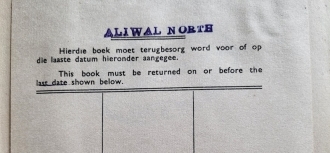
The town was laid out in 1849. When this happened, the Jewish mercantile firm, Mosenthals, opened a branch in the newly established town. After a few months, they sent a young man, Heinrich (later ‘Henry’) Bergmann (1831-1866), to manage the new store and to help sell land in the embryonic township. Very rapidly, Bergmann became one of the most prosperous people in Aliwal North. He owned much land and managed a bank in the town. Soon, he was so successful that he took over the town’s other two banks. For reasons that are not altogether clear, but they might have had something to do with a financial problem, Bergmann shot himself. Having committed suicide, neither the small Jewish cemetery nor the Christian one was prepared to bury him. In the end, his friends the De Wet family, who farmed in the district, buried him in their private family cemetery, and that is where we saw his gravestone when we visited Aliwal North in 2003.
Henry Bergmann was my mother’s grand uncle.
Arriving in what was then the Cape Colony in 1849, he was the first member of my family to migrate from Germany to southern Africa. He was also amongst the small number of Jewish people who came to that part of the world in the first half of the nineteenth century. The majority of Jewish migrants to what is now South Africa began arriving after the late 1860s, as I have described in my book “Exodus to Africa”.
We visited Aliwal North in 2003 as part of my research into the life of Henry Bergmann. Apart from meeting members of the De Wet family, descendants of those who buried Bergmann, who showed me family histories containing details of my ancestor’s life and fields that were once owned by him, we spent some time with Mrs Joubert, the librarian of Aliwal North’s public library. She was extremely helpful and took a great interest in my research.
Aliwal’s library was selling a few books that were no longer needed. My wife bought a few novels, one of which was “Mr Mirakel” by E Phillips Oppenheim (1866-1946). The book we bought contains the words: “First printed … 1943”. It is a first edition. Inside the book, there are labels inserted by the library. They are printed both in English and Afrikaans. There are also four imprints of an inked rubber stamp. Each one reads: “Aliwal North. Public Library. Cape of Good Hope.”
Just before 1910, when the Unification of South Africa occurred, what had been known as the Cape Colony became known as ‘The Cape of Good Hope Province; (‘often shortened to ‘the Cape Province’). In 1994, this vast territory was divided into the Northern Cape, Western Cape, and Eastern Cape provinces. Given that the book can only have been acquired in or after 1943, the words ‘Cape of Good Hope’ on the stamp intrigued me. Although they do refer to a geographic entity, they have never, as far as I can see, referred to an administrative area, and did not do so on or after 1943 when the book was published.
Had we not been sorting out our books recently, we would not have come across the book from Aliwal North. Seeing it and its library labels and stamps brought back memories of our visit to Aliwal North 22 years ago.
August 19, 2025
Writing for pleasure or for profit? That is the question.
I DERIVE GREAT enjoyment from writing. I enjoy researching the background material that will form the basis of what I will write. Then, I find it satisfying attempting to put my ideas into words because it helps me understand my subject matter and it is challenging to find ways of expressing my thoughts in ways that others will understand what I am ‘getting at’.
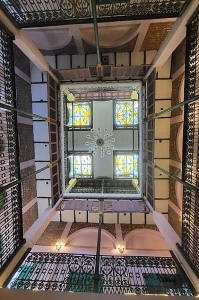 Azimganj, West Bengal, India
Azimganj, West Bengal, IndiaWhen my text is ready, I find it both challenging and interesting formatting the it and any illustrative material so that they ready for printing in book form. Designing the covers for the book and eBook is yet another pleasurable activity. The resulting production might not always be as satisfactory as what is sometimes produced by commercial publishers, but at least it is what I have conceived in my own mind: all my own work!
In the unlikely event of any of my books becoming ‘best sellers’, I would be both flattered and very happy. However, I write and publish for pleasure, not for profit. What matters most to me, and pleases me most, is knowing that at least a few people will read my books, and I hope gain something from them, be it information, enjoyment, or enlightenment.
And, just in case you are interested, my latest book, “88 Days in India: A Journey of Memory and Discovery”, is available in paperback (and Kindle) from Amazon:https://www.amazon.co.uk/dp/B0FKTFBFM2
August 18, 2025
Socket to me on Brick Lane in east London
BRICK LANE HAS become very ‘trendy’ (‘arty’ ?). When walking across the railway bridge along which Brick Lane runs, I noticed that the wall of the bridge had a surprising decorative feature.

The wall was covered with a mosaic-like pattern of electrical socket facings. These had been painted over or sprayed to create patterned graffiti such is found all along the northern half of brick Lane.
I have yet to discover who came up with the idea with using sockets as a wall covering.
August 17, 2025
From Lahore to London but he did not live long
THE WHITECHAPEL GALLERY in London’s Aldgate area often hosts exhibitions of adventurous art, and has been doing so for many decades. The current show “Hamad Butt: Apprehensions”, which is on until 7 September 2025, displays works by an artist Hamad Butt. He was born in Lahore (Pakistan) in 1962, and died of AIDS in London, aged only 32. His family brought him to London when he was 2 years old. He studied art at London’s Goldsmith College, Morley College, and Central Saint Martins.
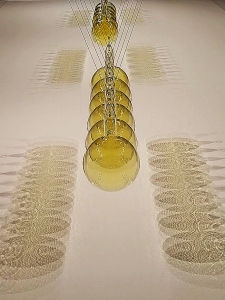 Familiars 3
Familiars 3The ground floor of the Whitechapel Gallery contains three enormous sculptures. Together they form an art installation, which the gallery’s website described as follows:
“Familiars 1: Substance Sublimation Unit is a steel ladder made of glass rungs, each filled with an electrical element and crystals of solid iodine. The current ascends the ladder, intermittently heating the rungs, causing the iodine to sublimate into a purple vapour. In Familiars 3: Cradle, named after Newton’s cradle, 18 vacuum-sealed glass spheres are filled with lethal yellow-green chlorine gas. If smashed together, the gas – a respiratory irritant – would be released into the air. In Familiars 2: Hypostasis, three tall, curved metal poles, reminiscent of Islamic arches, contain bromine-filled tubes at the tips.”
Well, they were visually intriguing pieces of conceptual art. What they stand for is almost more important than their physical appearance.
Upstairs, the galleries are hung with paintings, drawings, and prints. There is also another installation that contains a set of lights emitting ultraviolet rays. Visitors are provided with protective goggles when viewing this exhibit called “Transmission”, which is yet another example of conceptual art that you need to read about to make any sense of it.
What saved the exhibition for me was the display of Butt’s paintings and prints. Ranging from almost figurative to abstract, they appealed to me immediately. It is a shame the artist lived for such a short time. That which he produced in a few years, I am sure, would have led to him becoming a noteworthy artist with a fascinating output.
August 16, 2025
My latest book about travels in India is now available

MY LATEST BOOK invites you to join me on a fascinating 4000-mile, 88 day journey through parts of India including Karnataka, Rajasthan, West Bengal, Telengana, Tamil Nadu, and Pondicherry. My travelogue relates aspects of each place’s past and present; describes interesting encounters with diverse people – from autorickshaw drivers to artists and academics; and savours local foods. Immerse yourself in the pages of my illustrated account of a modern day Indian odyssey, and discover India without leaving home!
My book, “88 DAYS IN INDIA: A JOURNEY OF MEMORY AND DISCOVER” is available from Amazon websites, such as:
August 15, 2025
ENJOY INDIA WITHOUT LEAVING HOME
TODAY is the 15th of August, the anniversary of India becoming independent of British rule. What better day to announce the ‘launch’ of my latest book?
My new book invites you to join me on a fascinating 4000-mile, 88-day journey through parts of India including Karnataka, Rajasthan, West Bengal, Telangana, Tamil Nadu, and Pondicherry. My travelogue relates aspects of each place’s past and present; describes interesting encounters with diverse people – from autorickshaw drivers to artists and academics; and savours local foods. Immerse yourself in the pages of my illustrated account of a modern-day Indian odyssey, and discover the wonders of India without leaving home!
My book, “88 DAYS IN INDIA: A JOURNEY OF MEMORY AND DISCOVERY” is available from Amazon websites, such as:
https://www.amazon.co.uk/88-DAYS-INDIA-JOURNEY-DISCOVERY/dp/B0FKTFBFM2/

Signs of the times from Japan
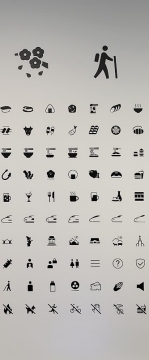
THE CURRENT EXHIBITION at Japan House in London’s Kensington is on until 9 November 2025. It is a display of pictograms past and present. A pictogram is a graphical symbol, which conveys meaning by resembling a physical object.
The exhibition not only details the history of pictograms but also displays a large number of these symbols from Japan and elsewhere.
As is usual for exhibitions at Japan House, the show is well laid out and informative. However, it did little to arouse my interest in the subject of pictograms.
August 14, 2025
When German bombs rained down on Hampstead and a pub that no longer exists
DURING MY CHILDHOOD in the 1960s, there was a concrete platform on Hampstead Heath Extension. It was close to Hampstead Way. Today, where it used to be visible, there is a mound of impenetrable bushes and weeds surrounded by a fence. The concrete structure was a base for anti-aircraft guns during WW2. Although, many German aircraft were knocked out of the sky by guns such as these, many of them caused a great deal of damage all over London. Recently, while sorting through some books, I came across a slender volume called “Hampstead At War”. It was first published by Hampstead Borough Council in 1946, republished by the Camden Historical Society in 1979, and then again in 1995. The book contains many photographs of the terrible destruction caused by bombs dropped by the Luftwaffe over Hampstead.
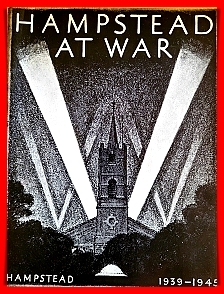
One of the photographs in the book struck a particular chord with me. It shows the badly damaged Hare and Hounds pub after it had been bombed in 1940. The pub, which was almost next door to the famous Old Bull & Bush pub, was established in about 1751. However, the building that was destroyed was built a long time after that.
Between 1965 and 1970, I used to travel From Golders Green station to Highgate School on the bus (route 210). Every school day, the bus would pass the Old Bull & Bush and its neighbour, the Hare and Hounds. When passing the latter in those days, I always wondered why the pub looked so recently built. When leafing through the “Hampstead at War” book today, more than 50 years after leaving the school, I found the answer. The book contains a photograph showing the extensively damaged pub.
The Hare and Hounds was rebuilt during the years I studied at Highgate. Although I can only faintly recall its appearance and can find only one photograph of it after its rebuilding, its presence remains firmly fixed in my memory. Finding the book certainly jogged my memory, and seeing the photographs of war damaged Hampstead makes a great impression. One wonders why the Germans chose to waste their ammunition on an area that has always been mainly residential.
PS: The Hare and Hounds closed forever in 2000.
August 13, 2025
Growing at Greys Court in Oxfordshire
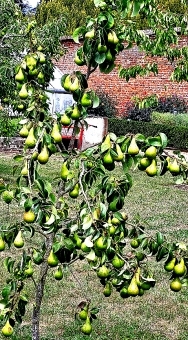
Pears ripening
Within a fine historic garden
Close to Greys Court
Greys Court is a house and garden in Oxfordshire, near to Henley-on-Thames. It is maintained by the National Trust.
August 12, 2025
A church left abandoned in a field in Oxfordshire
NOT FAR FROM Henley-on-Thames, lies the village of Bix. Its name might derive from either the Anglo-Saxon word for box, an evergreen shrub, or from a word, ‘behaeson’ meaning ‘to vow’. By 1085, when the Domesday Book was compiled, Bix was divided into two nearby settlements, each of which had its own church. One of these has disappeared, and the other, St James, is now in ruins.
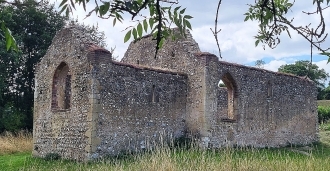
Still consecrated but in a dilapidated state, St James is now known as Bix Old Church. Very little is known about the early history of this ruined church. It was in existence by 1274, when it and the other church were so poor that they had to share a vicar. In the late 1700s, the walls of St James began to collapse. So, brick buttresses were constructed to prevent further damage. These buttresses are still standing, but they failed to halt the collapse of the church. In 1874, the church was deemed unusable, and a new church, the present St James, was built.
We visited the new church, arriving just in time to meet someone who was about to unlock it. Constructed in 1874, it is a Victorian gothic edifice. Inside, the church is built with bricks of differing colours arranged in layers to produce an eye-catching appearance. What makes this church fascinating is that it contains various things that were rescued from Bix Old Church: the font; two fragments of Flemish stained glass dating from 1530; and the carved stone bowl of the piscina. These valuable remains were moved from the old church to the newer one in 1875.
Bix Old Church is reached by a long country lane that is only wide enough for one car. It and the church are in surprisingly a rural environment, considering how close it is to places like Henley, Reading and High Wycombe. We visited the church mainly because when I passed a sign for Bix, which I thought was a strange name, I looked it up on the Internet later while enjoying a picnic, and found out about the existence of the ruined church. Once again, a short visit into the English countryside has resulted in an unexpected, fascinating discovery.



